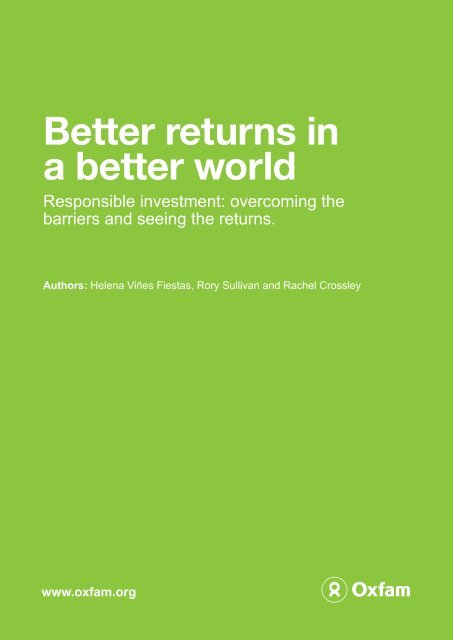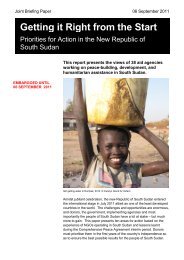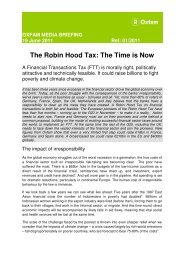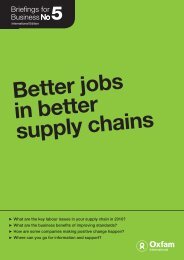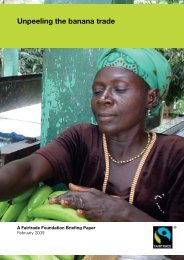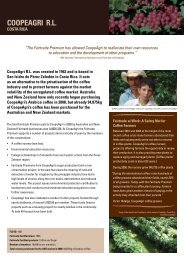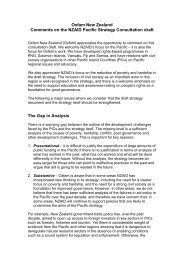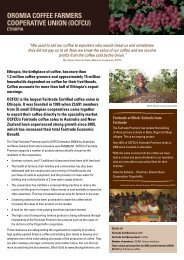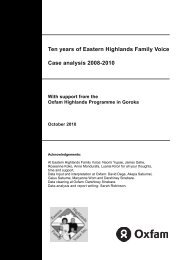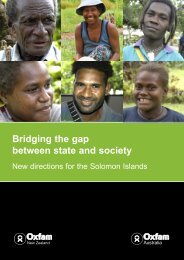Better returns for business.pdf - Oxfam New Zealand
Better returns for business.pdf - Oxfam New Zealand
Better returns for business.pdf - Oxfam New Zealand
- No tags were found...
Create successful ePaper yourself
Turn your PDF publications into a flip-book with our unique Google optimized e-Paper software.
1. Introduction“We can’t af<strong>for</strong>d not to invest in the developingworld. We all know that’s where the greatestneed is; but that is also where some of thegreatest dynamism is.” Ban Ki Moon,UN Secretary-General speaking at the UNGlobal Compact Leaders Summit, June 2010.
SIXBox 1: <strong>Better</strong> Returns in a <strong>Better</strong> World roundtablesAccess to Medicines, 7 April 2009, London, hosted by SustainAbility.Arms Trade, 2 June 2009, Stockholm, hosted by Ethix SRI Advisors.Decent Work in Global Supply Chains, 17 September 2009, London, hosted by AvivaInvestors.Access To Water, 24 September 2009, Paris, hosted by Crédit Agricole Cheuvreux.Food Security: Investing in Farmland, 12 January 2010, London, hosted by HendersonGlobal Investors, with the International Institute <strong>for</strong> Environment and Development.Private Equity Investing in Developing Countries, 27 January 2010, London, hostedby the Church of England Ethical Investment Advisory Group and the CommonwealthDevelopment Corporation.Transparency, Bribery and Corruption, 23 March 2010, <strong>New</strong> York, hosted by CalvertInvestments, with Transparency International and the US Social Investment Forum.This report summarizes the lessons learnedduring the course of the BRBW project, andmakes a series of recommendations to theinvestment community, policy makers andmore broadly to civil society. It is divided intofour chapters. Chapter 2 sets out the broadinvestment arguments around why investorsshould be concerned about poverty alleviationand development issues. This is important asit helps understand the limits to the ‘<strong>business</strong>case’ <strong>for</strong> action. Chapter 3 explains thespecific actions that investors can reasonablybe expected to take to contribute to povertyreduction. Chapter 4 discusses the majorstructural and technical barriers to investoraction identified in the course of the project.Finally, Chapter 5 sets out our proposals on howthese structural and technical barriers may beaddressed.1.2. Project scope and limitationsThe project focused on a specific part of thefinance sector, namely European and NorthAmerican institutional investors (in particular,pension funds, insurance companies andinvestment managers). It concentrated primarilyon investments in the shares of publicly listedcompanies (equity investment) and, to a limitedextent, on alternative investments, namelyprivate equity. 4OUR AIM WAS TO DISCOVER WHAT COULDBE DONE TO MAXIMISE THE POSITIVECONTRIBUTION INSTITUTIONAL INVESTORSCAN MAKE TOWARDS POVERTY REDUCTION.We chose this focus because it is in thesegeographic areas and in this asset class(i.e. listed equities) that the debate aroundresponsible investment is at its most advanced.Our aim was to identify and understand goodand best practices with the aim of discoveringwhat more can be done to maximize the positivecontribution that institutional investors can maketowards poverty reduction.
SEVENThe fact that the project was carried out againsta backdrop of unprecedented turmoil in theworld’s financial markets lent a particular urgencyand focus to our work. The World Bankestimates that 64 million more people will fallinto extreme poverty in 2010 due to theeconomic crisis. 5QUESTIONS HAVE BEEN RAISED ABOUTTHE PROPER ROLE OF INVESTORSIN SOCIETY, BOTH IN TERMS OF THESPECIFIC INVESTMENTS THEY MAKEAND THE EXTENT TO WHICH THEYTAKE INTO ACCOUNT WIDER SOCIETALCONSIDERATIONS.The financial crisis has undermined trust in theglobal financial system; financial institutions,and the market as a whole, have been criticized<strong>for</strong> short-termism, excessive speculation, poortransparency, and a lack of accountability toregulators or to wider society. Questions havealso been raised about the proper role ofinvestors in society, both in terms of the specificinvestments they make and the extent to whichthey take into account wider societalconsiderations when making those investmentdecisions. While our discussions with investorswere inevitably in<strong>for</strong>med by the more generaldebates around the causes of the financial crisisand the way in which trade and investmentpolicies affect progress on poverty reduction,this report is not intended to provide asystematic analysis of the global financial system. 6Finally, we recognize that some of therecommendations made in this report abouthow to overcome the structural and technicalobstacles faced by investors (when tryingto build poverty reduction and developmentissues into their investment processes) will befamiliar to investors involved in responsibleinvestment debates. We also recognize thata number of our recommendations reflectproposals that have been made <strong>for</strong> improvingthe financial system more generally in the wakeof the financial crisis, which, if agreed, couldproduce broader development benefits acrossthe finance sector. The important point is thatthe proposals must emerge as priorities if weare to make real progress towards buildingpoverty alleviation and development into themainstream of investment practice.
2. Why investors should seek tocontribute to poverty reduction“As a long time fund manager I recognize theopportunities <strong>for</strong> investment that emergingmarkets offer. However, a failure to effectivelyaddress poverty-related issues such asaccess to medicines can be a critical riskto future profitability and so to investment<strong>returns</strong>.” John Schaetzl, Chair, SustainAbility,adviser of two global funds, <strong>for</strong>mer fundsmanager <strong>for</strong> General Electric, and healthcare analyst.
NINE<strong>Oxfam</strong> is a rights-based organization. We believethat investors have an ethical duty to take properaccount of environmental and social issues in theirinvestment processes and practices. 7 This positionis in<strong>for</strong>med both by the practical recognitionthat investors are a major influence in and ofthemselves, and by the premise that underpinsinternational human rights law and conventions– that ‘all organs of society’, including companiesand investors, have obligations to protect andpromote human rights. Within this context, <strong>Oxfam</strong>sees poverty reduction as integral to the deliveryof the most basic human rights.Beyond the moral arguments, we recognizethat there are also compelling financial and<strong>business</strong> reasons <strong>for</strong> investors to be concernedabout poverty and development issues. Theseinclude the potential opportunities presented byemerging markets, the financial risks associatedwith operating or investing in these markets,and the growing social and regulatory pressures<strong>for</strong> investors to take a proactive approachto managing these issues. We review these<strong>business</strong> drivers in more detail here because, inpractice, the level of attention paid by investors topoverty and development issues (and the actionstaken on these issues) is critically dependent onthe nature and intensity of these pressures.THERE ARE COMPELLING FINANCIAL ANDETHICAL REASONS FOR INVESTORS TOBE CONCERNED ABOUT POVERTY ANDDEVELOPMENT ISSUES.First, in relation to the opportunities, investorssee emerging markets in general, and specificsectors within them, as important sources offuture growth and <strong>returns</strong>. 8 The investment caseis rein<strong>for</strong>ced by the structural drivers of growthin these countries. These include growingpopulations, the need <strong>for</strong> significant investmentsin infrastructure and other fixed assets, thegrowth in the size of the ‘middle classes’, andincreases and changes in consumption (e.g.moves from grain to meat-based diets). Thesepressures in turn are driving growing investorinterest in assets such as land and water astheir value and demand rises due toincreasing scarcity.While the opportunities are obvious, so tooare the risks. These include factors such aspopulation growth, the inevitable changes insocial structures that ‘modernisation’ brings,increasing competition <strong>for</strong> natural resourcessuch as agricultural land, <strong>for</strong>ests and water,and the governance and implementation issuesassociated with contributing to sustainableand equitable development. All these presenthuge challenges <strong>for</strong> investors. They may affectinvestors as a consequence of higher costs (e.g.higher costs <strong>for</strong> water and other inputs, higherexpenditures on stakeholder engagement,higher transport costs), increased risk of protestsor conflict (with consequent implications <strong>for</strong><strong>business</strong> continuity and/or the need <strong>for</strong> increasedsecurity), damage to the company’s reputationor to the reputation of its investors, or even tothe loss of the investment (e.g. if a factory oroperation has to shut permanently).Opportunities versus risksThese challenges are particularly wellillustrated in the case of the growing investorinterest in farmland, where water 9 and landrights are frequently integral to the investmentcase. In the BRBW roundtables on access towater and agricultural land (see Box 2), thechanging debate around water – particularlythe emergence of access to water as a humanrights issue – was seen as an issue that couldresult in institutional investors themselves beingexplicitly challenged on their approaches towater management or lack of consultation withlocal communities. Even among those investorsthat proactively engage with companies onthese types of issues, it was recognized that thestandard investor expectation that companiesuse water efficiently is unlikely to be sufficient toaddress the risks associated with conflict overwater resources. It was noted that companiesin sectors that rely heavily on water <strong>for</strong> theirproduction processes (including utilities,
TENbeverages, metals and mining, food, pulp andpaper, textiles and chemicals) are particularlyexposed. It was agreed that companies andtheir investors would be required to pay muchcloser attention to the social dimensionsof water than they have done in the past.Moreover, their decisions (including whetherto proceed with projects, and the amount ofwater to be used) will need to be based notonly on an assessment of the direct financialcosts and benefits, but also by issues suchas the human rights and needs of localcommunities, the carrying capacity of the local/regional environment, the views of stakeholders(including international NGOs and localcommunities) and the manner in which waterresources are likely to change over time as aconsequence of climate change.Box 2: Farmland FundsThe interest of institutional investors in land-based investments is a relatively newphenomenon, driven both by the expectation of rising <strong>returns</strong> from agriculture linkedto changing agricultural commodity prices (driven by increasing demand <strong>for</strong> foodand bio fuels and, potentially, the economic value associated with carbon sinks) andland appreciation, as well as portfolio diversification. According to the World Bank,‘compared to an average annual expansion of global agricultural land of less than 4million hectares be<strong>for</strong>e 2008, 45 million hectares worth of large scale farmland dealswere announced even be<strong>for</strong>e the end of 2009. More than 70 per cent of such demandhas been in Africa, and countries such as Ethiopia, Mozambique and Sudan havetransferred millions of hectares to investors in recent years.’ 10 While agriculture andparticularly farmland as an asset class is still in its infancy, it is expected that investorswill continue to increase their investments in agriculture globally.The participants in the <strong>Better</strong> Returns in a <strong>Better</strong> World workshop on land-basedinvestments 11 raised a series of concerns about the manner in which investors areapproaching these investments, including:• There is a wide variation in investors’ knowledge and understanding of emergingmarkets in general and of individual countries or communities in particular.• There is a shortage of good farm management skills and/or knowledge of the sectoramong institutional investors. This means that investors may not be able to ensure thatenvironmental and social risks are identified and properly managed.• There is a general lack of transparency on the investments that are being made, thesocial and environmental impacts that result and the measures being adopted tomanage risks and maximize the development benefits.• There is frequently a tension between investors’ timeframes (which are generally veryshort) and expectations on investment <strong>returns</strong>, and the <strong>returns</strong> that can be reasonablyexpected from such investments.• Key risks like food and water security and the wider consequences of land sales arenot generally considered by investors in their investment decisions.• The interests and rights of local communities are frequently not taken into account. Inmany cases, local communities have no involvement in the sale process.
ELEVENWhile the debates around access to water andagricultural land offer the clearest examples ofthe risks faced by investors, a similar pictureemerges in other areas. For example, emergingeconomies are expected to provide 50 per centof the future pharmaceutical market growthby 2020, 12 This has <strong>for</strong>ced pharmaceuticalcompanies to consider how they can adapttheir <strong>business</strong> models to address the pricing,research and development, and intellectualproperty issues that impact on access tomedicines in order to protect their long-termshare value. 13PENSION FUNDS AND FUND MANAGERSTHEMSELVES, AS WELL AS THECOMPANIES IN WHICH THEY INVEST, HAVESTARTED TO BECOME THE TARGET OFCIVIL SOCIETY CAMPAIGNS.Bribery and corruption is another major issue <strong>for</strong>investors, which potentially affect all sectors ofthe economy. In the BRBW workshop on briberyand corruption, 14 participants expressed concernabout the mounting hidden cost of corruptioninvestigations. The direct financial cost ofone case study presented in the workshopwas calculated at $293 million; this was inaddition to the unquantifiable costs associatedwith reputation damage and managementdistraction. 15Growing social and regulatory pressureApart from the financial case <strong>for</strong> action,investors are facing increasing scrutiny andpressure from governments, media and civilsociety as a result of the growing expectationsof investors to be transparent and accountable<strong>for</strong> their social and environmental impacts.Perhaps the most high profile example inrecent years has been the campaign <strong>for</strong> theinternational prohibition of cluster munitions,which has seen investors being explicitlytargeted. These campaigns have beenparticularly successful in the Netherlands andScandinavia where pension funds were directlytargeted. An increasing number of investorsnow have explicit prohibitions on investing incompanies involved in the production of clustermunitions: <strong>for</strong> example, UBS Global AssetManagement, 16 Norway Pension Fund and the<strong>New</strong> <strong>Zealand</strong> Superannuation Fund, Belgianbank KBC, Dutch bank ING, Dutch Pensionfunds PGGM and ABP.Beyond specific NGO campaigns, there is moregeneral pressure <strong>for</strong> institutional investorsto take a more responsible approach to themanner in which they conduct their investmentactivities, and these pressures are likely to growover time. Pension funds and fund managersthemselves, as well as the companies inwhich they invest, have started to become thetarget of civil society campaigns. For example,FairPensions 17 in the UK and VBDO 18 in theNetherlands both benchmark pension fundsand fund managers on their per<strong>for</strong>mancein managing environmental, social andgovernance issues, and publish the names ofgood and poor per<strong>for</strong>mers.“What has changed is thatstraight<strong>for</strong>ward legal complianceis no longer sufficient. Societal,market and investor expectations aremuch higher and are continuing torise. The companies that will be thewinners of the future will be thosethat can anticipate and exceed theseexpectations”. Nick Robins, Headof Climate Change Centre, HSBC
FOURTEENDevelopmentissues are fullyintegrated intoinvestmentprocesses andengagement withcompaniesSocietiesattract moreresponsibleinvestmentInvestorsinvest incompanies thattake account ofand manage theirdevelopmentimpacts wellSocietiesbecome moreattractiveplaces to investThosecompanies aremore profitableand sustainable;their investorsmake higher<strong>returns</strong> in thelong runEconomicgrowth is moresustainable andequitable
FIFTEENRole 2: Stock selectionInvestors can take development issues intoaccount in their stock selection in a variety ofways: 20• Negative screening, where companies areexcluded from investment on the basis ofdefined ethical criteria. These criteria may referto products (e.g. alcohol, tobacco), activities(e.g. gambling), <strong>business</strong> sectors (e.g. oil,mining, banking), countries (e.g. Sudan,Burma) or international norms (e.g. internationalstandards such as those derived from UN orother international conventions).• Positive screening, where companies areselected <strong>for</strong> investment because of theirenvironmental or social benefits (e.g.companies that produce energy from renewablesources, companies involved in the provision ofhealthcare).• Best in class, where companies with bettergovernance and management processes,and/or with better per<strong>for</strong>mance on specificenvironmental and/or social issues, arepreferentially selected <strong>for</strong> investment.• Integrated analysis, which involves the explicitconsideration of environmental and socialimpacts in their investment research.INVESTOR ENGAGEMENT HAS LED TOCHANGES IN COMPANY PERFORMANCE,NOTEWORTHY EXAMPLES RELATINGTO ACCESS TO MEDICINES, LABOURSTANDARDS AND CLIMATE CHANGE.These strategies differ in terms of theimportance assigned to social andenvironmental per<strong>for</strong>mance versus investment(financial) per<strong>for</strong>mance. In negatively screenedapproaches, companies, generally, must meetminimum per<strong>for</strong>mance standards be<strong>for</strong>e theycan be invested in; in other strategies, thetrade off between social and environmentalper<strong>for</strong>mance and investment per<strong>for</strong>mance isnot clear-cut. Apart from funds with specificexclusionary criteria, investment managers tendto see divestment very much as a last resort.Role 3: Influencing corporate practicethrough engagement and voting 21Investors have an important role to play inencouraging the companies in which they areinvested to set and maintain high standardson a wide range of corporate responsibilityand corporate governance issues. Theyhave a range of strategies they can use todeliver these outcomes: both the <strong>for</strong>mal rightsgranted to them as shareholders (e.g. votingon shareholdings, the ability to call emergencygeneral meetings) and, equally importantly, thein<strong>for</strong>mal influence that they have – individuallyand collectively – as the providers of capitalto these companies. The views that investorsexpress in meetings and other communicationswith company management about social andenvironmental per<strong>for</strong>mance can have animportant influence on the weight assigned bycompany management to these issues and theactions they decide to take.There is a growing body of evidence thatinvestment engagement – individually andcollectively – can have a positive influence oncompany per<strong>for</strong>mance. Over the past decade,investor engagement has led to improvementsin companies’ corporate governance, in thesystems and processes that companiesfollow <strong>for</strong> the identification and managementof environmental and social issues, and inthe quality of the in<strong>for</strong>mation that companiesprovide to their investors and the wider society. 22
SIXTEENInvestor engagement has also led to changesin company per<strong>for</strong>mance, with particularlynoteworthy examples relating to accessto medicines (where investors lent strongsupport to <strong>Oxfam</strong>’s Cut the Cost and Novartiscampaigns), labour standards (whereinvestors encouraged companies to improvetheir monitoring and management of labourstandards in their supply chains) and climatechange (where investors have encouragedcompanies to reduce their greenhouse gasemissions). 23While, in the main, investors have tended tofocus most of their attention on issues wherethere is a clear <strong>business</strong> case <strong>for</strong> action,there have also been examples of investorswilling to move beyond those situations wherethe <strong>business</strong> benefits clearly outweigh thecosts. For example, Boston Common AssetManagement (US) and Storebrand (Norway)supported Intermón <strong>Oxfam</strong> in their call <strong>for</strong>Spanish oil company, Repsol to commit todisclosing its payments to governments, andsupported the inclusion of binding country-bycountrydisclosure in a potential new accountingstandard to be adopted by the InternationalAccounting Standards Board (IASB) <strong>for</strong> theextractive sector in 2010. 24 In June 2010,Chevron investors, representing $10 billion inshares, supported a shareholder proposal filedby <strong>Oxfam</strong> America, calling on the company todisclose its payments to governments. 25Some investors have – individually orcollectively – done benchmarking to assesscompanies’ relative per<strong>for</strong>mance as part oftheir engagement strategies. Examples includethe climate change, biodiversity and labourstandards benchmarks developed by InsightInvestment, 26 the Carbon Leaders DisclosureIndex produced by the Carbon DisclosureProject, 27 the ICCR benchmark 28 and the Accessto Medicine Index. 29 The key feature of theseindices is that they create additional incentives(i.e. beyond those in conventional costbenefitassessments) to improve companies’per<strong>for</strong>mance, with the potential <strong>for</strong> enhancedbrand and reputation benefits to the leaders inthese benchmarks. The other important featureis that they provide a structured basis <strong>for</strong> adialogue between companies and their investorsaround how specific issues are being managed. 30TO DATE, FEW SHAREHOLDERRESOLUTIONS RELATING TO COMPANIES’ENVIRONMENTAL AND SOCIALPERFORMANCE OR REPORTING HAVEBEEN FILED.It is interesting to note that, particularlyamong European investors, relatively littleuse (in relation to social and environmentalper<strong>for</strong>mance) has been made of <strong>for</strong>malshareholder rights. To date, few shareholderresolutions relating to companies’ environmentaland social per<strong>for</strong>mance or reporting have beenfiled. In contrast, in the United States, the use of<strong>for</strong>mal voting rights is much more widespread.For example, in 2008 alone, over 50 climatechange-related shareholder resolutions werefiled. Almost half of these resolutions weresubsequently withdrawn when the companiesmade commitments to set targets to reduce theirgreenhouse gas emissions. 31 It appears that themajor reason <strong>for</strong> the difference is that Europeaninvestors, generally, seem to have better accessto and relationships with company boards andso are more willing to engage in dialogue withcompany management. Lodging a resolution orvoting against management is generally seen asan action of last resort.
SEVENTEENRole 4: Influencing public policyMany of the most significant poverty reductionand development challenges result fromweaknesses in public policy frameworks. Whileinvestor engagement can do much to encouragecompanies to take a more proactive approachto these issues, the reality is that effective actionis in many cases constrained by limitations inpublic policy. Investors have recognized thisproblem and a number have sought to work withpolicy makers to address these gaps. Two goodexamples are investors’ support of the ExtractiveIndustries Transparency Initiative (EITI) 32 and thepublic policy work of the Institutional InvestorsGroup on Climate Change (IIGCC). 33EITI is a multi-stakeholder initiative involvingoil and mining companies, governments, civilsociety organisations and institutional investors.It seeks to promote fiscal transparency and goodpublic governance in countries with a historyof misusing extractive revenues. It does thisby enlisting both the extractive companies thatoperate there to declare their tax, bonus androyalty payments, and the recipient governmentsto declare what payments they receive. Bymid-2009, 76 investors with some $13 trillion ofassets under management had explicitly backedthe EITI by signing an ‘investor statement’.MANY OF THE MOST SIGNIFICANTPOVERTY REDUCTION ANDDEVELOPMENT CHALLENGES RESULTFROM WEAKNESSES IN PUBLICPOLICY FRAMEWORKS.This investor support is widely recognizedas having played an important role in gettingcompanies to sign up to the EITI and to reportin<strong>for</strong>mation in line with the requirements of EITI.The Institutional Investors Group on ClimateChange (IIGCC) is a <strong>for</strong>um where morethan 50 European pension funds and assetmanagers representing around €50 trillion actcollectively to use their ‘significant collectiveinfluence to engage in dialogues with policymakers, investors and companies to acceleratethe shift to a low carbon economy.’ 34 Amongother activities, the IIGCC has sought to makea constructive contribution to internationalclimate change negotiation processes, calling<strong>for</strong> a strong global climate change treaty withambitious emission reduction targets. 35These kinds of voluntary initiatives can havesignificant benefits both by encouraging positiveaction and by helping to establish the need<strong>for</strong> effective regulation and en<strong>for</strong>cement bygovernments of coherent public policies thatprotect human rights and promote povertyreduction. In <strong>Oxfam</strong>’s view, responsibleinvestors have a clear interest in supportingstate regulation on these issues as it createsa level playing field <strong>for</strong> all companies andestablishes clear company per<strong>for</strong>mancestandards while encouraging good practice andinnovation.3.2 Responsible investment entering themainstream of the investment industryThe argument that investors have social andenvironmental responsibilities is increasinglyaccepted in the investment industry. This ismost clearly seen by the number of signatoriesto the UN-backed Principles <strong>for</strong> ResponsibleInvestment (PRI). As of the end of October2010, 827 investors, with the responsibility<strong>for</strong> more than $25 trillion of assets, andrepresenting 15 per cent of total global markets,had become signatories to the PRI. 36
NINETEENBox 3: The UN Principles <strong>for</strong> Responsible InvestmentThe Principles <strong>for</strong> Responsible Investment (PRI), launched in 2006, were developedby institutional investors, and are supported by the UN Global Compact and the UNEnvironment Programme, with the direct support of the UN Secretary-General. They areintended to develop and promote best practice in the area of responsible investment,by facilitating the integration of environmental, social, and governance issues intomainstream investment practice. As such, they pledge to adopt the following principles:“As institutional investors, we have a duty to act in the best long-term interests of ourbeneficiaries. In this fiduciary role, we believe that environmental, social, and corporategovernance (ESG) issues can affect the per<strong>for</strong>mance of investment portfolios (tovarying degrees across companies, sectors, regions, asset classes, and through time).We also recognize that applying these Principles may better align investors with broaderobjectives of society. There<strong>for</strong>e, where consistent with our fiduciary responsibilities, wecommit to the following:1. We will incorporate ESG issues into investment analysis and decision-makingprocesses.2. We will be active owners and incorporate ESG issues into our ownership policies andpractices.3. We will seek appropriate disclosure on ESG issues by the entities in which we invest.4. We will promote acceptance and implementation of the Principles within theinvestment industry.5. We will work together to enhance our effectiveness in implementing the Principles.6. We will each report on our activities and progress towards implementing the Principles.”
TWENTY ONE4.1 Introduction4.2 Structural barriersDespite the growing number of investors making The project identified three critical structuralcommitments to responsible investment, and barriers in the investment sector that prevent thethe integration of social and environmental greater consideration of development issues inissues in their investment processes, one investment practice. These are:of the central conclusions of our research is• The lack of demand from, and oversight by, assetthat poverty reduction and development areownersnot, at present, seen as integral parts of theresponsible investment debate. While investors • Short-termism: Mismatched time frames betweenhave done work on topics such as revenue investment horizons and development issuestransparency, labour standards and bribery and • The general lack of transparency in thecorruption, this work seems in the main to have investment industrybeen carried out in a relatively ad hoc manner,triggered by media reports or civil societyLack of demand from, and oversight by, assetcampaigns rather than starting from a structuredownersanalysis of development issues as a whole.There was strong consensus among BRBWproject participants that a fundamental reason<strong>for</strong> the failure to consider development issueswithin the investment industry is the systemiclack of demand from asset owners (e.g. pensionfunds, foundations), insurance companies, andindividual investors (retail investors, high-networth investors). This lack of demand or interestextends much wider than poverty reductionand development. Our research suggests thatthere is a systematic absence of demand <strong>for</strong>The participants in the seven workshops and responsible investment in the round. Many of12 interviews conducted as part of the <strong>Better</strong> the BRBW participants expressed frustrationReturns in a <strong>Better</strong> World project identified a that their ef<strong>for</strong>ts on responsible investment didseries of barriers within the investment sector not seem to be a factor in the decisions madethat have contributed to this situation. We have by clients in their fund manager appointmentdivided these into two: structural barriers (see or reappointment processes. A number alsoSection 4.2) and technical barriers (see Section highlighted the almost complete absence of4.3). The structural barriers relate to the manner oversight as to how investment managersin which the investment sector itself functions actually implement their clients’ responsibleand, as noted in Chapter 1, many of the barriers investment commitments and policies.we identify reflect the criticisms that have beenmade of the finance sector in the fall out fromthe financial crisis. In contrast, the technicalissues are unique to the role of institutionalinvestors in poverty reduction, as they relate tothe manner in which poverty and developmentissues (as opposed to environmental, socialand governance issues more generally) can beintegrated into investment practice.PARTICIPANTS EXPRESSEDFRUSTRATION THAT THEIR EFFORTSON RESPONSIBLE INVESTMENT DIDNOT SEEM TO BE A FACTOR IN THEDECISIONS MADE BY CLIENTS IN THEIRFUND MANAGER APPOINTMENT ORREAPPOINTMENT PROCESSES.
TWENTY TWOThese findings – on the lack of client demandand oversight – may seem surprising, given thatthe UN PRI had 210 asset owner signatoriesas of the end of September 2010. Moreover, 10countries 39 have introduced regulations that – inbroad terms - require asset owners to adoptpolicies that set out their views on the relevanceof ESG issues to their investments and explainhow these are to be implemented.Participants identified several reasons why assetowners are not paying particular attention toresponsible investment issues in general, andpoverty reduction in particular. The most commonreason identified was the overwhelming focus onshort-term investment per<strong>for</strong>mance (discussedfurther below) to the virtual exclusion of widerresponsible investment issues. A number of otherfactors were also identified:• A general scepticism about the investmentbenefits – in particular over the short term – ofresponsible investment.• A general lack of understanding of how andwhy poverty reduction and development couldbe relevant to investment, and a general viewthat these issues are simply not relevant toinvestment per<strong>for</strong>mance.• A reluctance to be seen as a ‘social activist’ or‘campaigning NGO’.• A lack of pressure from clients, stakeholders orindustry peers to take action on these issues,and an unwillingness to take a leadershipposition.• A perception that focusing on these issues wouldentail incurring additional costs or risk damaginginvestment per<strong>for</strong>mance.Short-termism: mismatched timeframesA critical point highlighted by BRBW participantsis the short-term focus of most investmentcontracts (or mandates). The stereotype is thatthese mandates are typically <strong>for</strong> a three-yearperiod, with one-year per<strong>for</strong>mance targetsand quarterly reviews. Inevitably, this drives afocus on short-term financial per<strong>for</strong>mance, withdecisions to buy and sell shares based on likelyshort-term movements in share prices rather thanon a view of the companies’ longer-term strategyand prospects.THE MOST COMMON REASON IDENTIFIEDWAS THE OVERWHELMING FOCUSON SHORT-TERM INVESTMENT TOTHE VIRTUAL EXCLUSION OF WIDERRESPONSIBLE INVESTMENT ISSUES.This has two perverse consequences. First, itprovides incentives <strong>for</strong> companies to focus onactivities that yield <strong>returns</strong> in the short-term (i.e.boosting their quarterly financial results), ratherthan on activities that will lead to success over10 or 20 years (such as investing in strategies tomaximize their development impact in emergingmarkets). Second, it reduces the incentives<strong>for</strong> investors to engage with the companies inwhich they invest on issues that may providelonger-term benefits to the company. As sharesare likely to be sold long be<strong>for</strong>e these benefitsemerge, investment managers are unlikely to seethis engagement as being of benefit to them ortheir clients.
TWENTY FOURThe lack of transparency in the investmentsectorThe third major structural issue is the generallack of transparency in the investment industry.The vast majority of asset owners and assetmanagers provide little or no in<strong>for</strong>mation ontheir approaches to responsible investment;in most cases, disclosure is confined to arelatively general high-level policy. Whilethere has been some progress (e.g. 40 percent of PRI signatories now publish theresponses they provide to the annual PRIimplementation survey), 45 very few institutionalinvestors provide a coherent and completeaccount of: (a) how they give effect to theirpolicies; (b) what resources they allocate toresponsible investment; (c) what engagementthey conduct, and what outcomes result fromthis engagement; (d) how they take accountof ESG issues in their investment processesand the investment results that such a focushas provided, and (e) whether and underwhat conditions they collaborate with otherinvestors 46 . The consequence is that it is simplynot possible to assess whether an investor’sresponsible investment commitments have hadany impact on investment per<strong>for</strong>mance or socialor environmental outcomes.Lack of transparency presents two importantchallenges to the investment industry. First,given that transparency is one of the coreprinciples of the PRI, there is a real riskthat companies will push back on investordemands <strong>for</strong> more disclosure on the groundsthat investors themselves are not transparentabout how they use this in<strong>for</strong>mation. Second,the systemic lack of transparency runs the riskof undermining the credibility of initiatives suchas the PRI. If the PRI is not seen as a credibleinitiative, this will, in turn, limit the value ofthe PRI to investors. A similar argument canbe applied to individual investors. Withouttransparency on implementation, their rhetoricand policy commitments will simply not be seenas credible.“Transparency is crucial. Bothasset owners and managers shouldhave a publicly available strategythat underpins their principles andESG approach. They should bepublicly transparent on their valuesand per<strong>for</strong>mance so that peoplecan differentiate between them.”Giuseppe van der Helm,Executive director of VBDO andPresident of EUROSIF4.3 Technical barriersThe <strong>Better</strong> Returns in a <strong>Better</strong> World projectidentified a number of technical barriersthat limit the ability of investment managersto account fully <strong>for</strong> poverty reduction anddevelopment issues in their investmentprocesses. These fall into two categories:• Practical difficulties in valuing these issues and,even in situations where they can be valued,ensuring: (a) they are given appropriate weightin investment decisions, and (b) they havedesirable social outcomes.• The general absence of clear normativeframeworks (whether defined in regulation or inwidely supported codes and standards) againstwhich company per<strong>for</strong>mance can be assessedand which can <strong>for</strong>m the basis <strong>for</strong> dialoguebetween companies and their investors.MOST ASSET OWNERS AND MANAGERSPROVIDE LITTLE OR NO INFORMATION ONTHEIR APPROACHES TO RESPONSIBLEINVESTMENT. THIS MAKES IT VERYDIFFICULT TO ASSESS WHETHER THEIRRESPONSIBLE INVESTMENT STRATEGIESHAVE HAD ANY IMPACT ON PERFORMANCEOR SOCIAL OR ENVIRONMENTAL OUTCOMES.
TWENTY FIVEPractical Challenges in Valuing and IntegratingPoverty Reduction and Development IssuesInvestors face some very real practicalchallenges in integrating poverty reductionand development issues into their investmentdecisions.WHILE THERE IS NOW AN EXTENSIVEAND ROBUST LITERATURE ON THEINVESTMENT IMPLICATIONS OF CLIMATECHANGE AND OTHER ENVIRONMENTALISSUES, SOCIAL ISSUES (HUMANRIGHTS, POVERTY, DEVELOPMENT)HAVE RECEIVED NOTHING LIKE THESAME LEVEL OF ATTENTION WITHINTHE INVESTMENT COMMUNITY.However, the answer is not simply to arguethat investment banks should produce moreresearch on these issues. A number of practicalhurdles would need to be overcome be<strong>for</strong>e highquality and credible research can be produced.These hurdles include:• The general weaknesses in corporatedisclosures on social issues.• The lack of clear – and accepted – correlationsbetween commonly used measures of corporatesocial per<strong>for</strong>mance (e.g. the existence ofhuman rights policies, supply chain auditing)and measures of financial or investmentper<strong>for</strong>mance.• The difficulties in predicting the socialconsequences of environmental issues (see, <strong>for</strong>example, the water example in Box 6).There is a general absence of investmentrelevantresearch and financial tools that canbe used by investors to assess the financialsignificance of these issues. While there isnow an extensive and robust literature on theinvestment implications of climate changeand other environmental issues, socialissues (human rights, poverty, development)have received nothing like the same level ofattention within the investment community. Theconsequence has been that many investmentmanagers are simply not aware of the nature,scale and risks associated with developmentissues. The general absence of such researchpresents another problem as it suggests toinvestment managers that these issues are notrelevant to their investments; put another way,the absence of research rein<strong>for</strong>ces investmentmanagers’ prejudices about the lack of financialrelevance of these issues.• The difficulties in assigning a financial value toparticular social impacts, (see the example ofliving wage in global supply chains in Box 5).
TWENTY SIXBox 5. Integrating living wage in global supply chains into investment analysis 47The integration of company per<strong>for</strong>mance on environmental and social issues into investment practicesis important <strong>for</strong> two reasons: (a) it signals to company management that these issues are important toinvestors, and (b) the findings can be used as a basis <strong>for</strong> dialogue between companies and their investors.On September 2009, in partnership with Aviva Investors, we held a workshop where participants – a mixof investors and labour and supply chain experts – reviewed a piece of investment research 48 that tried toanalyse whether it was possible, based on an analysis of sales prices and knowledge of margin within thesupply chain, to determine what wages companies were paying to workers in their supply chains. The aimwas to establish whether such research could identify companies not paying a living wage to workers in theirsupply chain, with investors then engaging with these companies to encourage them to address this issue.The discussions highlighted the challenges inherent in assessments of this type, with participants identifyinga series of technical challenges as well as the risk of perverse or undesired outcomes.A number of technical obstacles were identified. First companies might be reluctant to provide in<strong>for</strong>mationon salaries/wages due to perceived commercial sensitivities, or because they have not calculated them (e.g.companies with long supply chains, those purchasing through intermediaries, those using sub-contractors).Second, the analysis was based on a series of assumptions around productivity (items/hour), hourly payand the length of the working week. The analysis did not take account of the potentially wide variation inthe wages received by individual workers, the significant variance in productivity even across workers in thesame factory (e.g. individual productivity rates often vary by from 0.5 units per sewer per hour to 1.75 piecesper sewer per hour) or the wide range of working hours per employee (which is typically over 60 hours perweek but <strong>for</strong> individuals could average from 65 to 90 hours per week). Third, multiple employees tend to beinvolved in the production of individual items and there is extensive subcontracting. These factors were notconsidered in the calculation methodology.Beyond the technical issues, the workshop participants noted the risks of perverse outcomes if suchresearch is used by investors to push companies to reduce labour costs to the level of those paid by theirpeers (i.e. creating a race to the bottom). Even if investors engaged in constructive dialogue to encouragecompanies to increase wage rates, there is a risk that companies might weaken other contractual benefits,thereby increasing the downward pressure on real wages That is, simply raising the rate of pay per piecemay not deliver better social outcomes, if higher payment comes at the expense of losing other benefitsParticipants concluded that, despite the difficulties, there were considerable benefits in such models andquantification when and if:• They are used as a basis <strong>for</strong> in<strong>for</strong>med engagement between investors and companies on wage issues.• The scope of engagement is confined not only to wages, but also covers wider employment issues.A wider conclusion was that there are, potentially, very real benefits <strong>for</strong> investors to engage closely with civilsociety organisations, as these organizations can not only help verify assumptions and data, but can alsohelp improve the engagement investors have with companies.
TWENTY SEVENWhile the absence of financial tools and credibleresearch on investment implications is a widelyacknowledged problem, it is important torecognize that this is an area where there is asignificant level of activity. A number of researchproviders have started to develop risk exposureand assessment tools; examples includeresearching and identifying high risk countriesfrom a human rights or conflict perspective,identifying critical or sensitive natural resources,and developing benchmarks and frameworks <strong>for</strong>assessing corporate per<strong>for</strong>mance on issues suchas labour standards and bribery and corruption).It is likely that, over time, these will address someof the major technical challenges listed above.Even if we overcome the technical issues aroundthe quantification of social issues in financialterms, it is important to recognize that there area number of factors that make it clear that thisis not necessarily the panacea that might beexpected. That is, it is likely that poverty reductionand development issues will continue to beunderplayed in investment analysis and decisionmaking.First, valuation models generally onlyproject <strong>for</strong>ward three, or sometimes five years.Impacts that occur outside such timeframes aregenerally ignored.Longer-term consequences, even those with a highprobability of occurrence (e.g. climate changerelatedimpacts) are generally not considered ininvestment models. Second, impacts that occur inthe future are assigned a lower importance thansimilar impacts today. Third, as many significantsocial and environmental impacts are simply notfinancially material (i.e. they have a modest effecton companies’ earnings or profits), they tend tobe excluded from investment analysis. Finally,because social and environmental issues interact incomplex ways, it is often not possible to capture allof these issues in a single (financial) metric.Box 6: Taking into account the multiple dimensions of water risksThe BRBW roundtable focused on water risks in water-scarce environments. Theinvestors participating in this workshop reported that they do look at water-related risksin their investment analysis, and that – where financially significant - they considerlikely changes in water and waste water volumes and costs as an integral part of theirinvestment research. These investors also noted that they evaluate companies’ qualityof management using eco-efficiency metrics (e.g. volume of water used per volume ofproduction).The workshop concluded that this focus on eco-efficiency, while an importantdimension of the debate, would not be sufficient to capture the social dimensions ofwater (e.g. the risk of conflict, legal disputes or disruption to production as a result offactors such as disputes with communities’ over their legal and customary access towater, human rights to water, competition <strong>for</strong> water resources from other uses {e.g.industry, agriculture} or changes in rainfall patterns as a consequence of climatechange.) While the need <strong>for</strong> a more holistic approach was recognized; investors notedthat it is difficult to assess companies’ approach to these issues objectively (e.g.companies’ approach to community relations) and to integrate such in<strong>for</strong>mation intoassessments of companies’ ‘quality of management’.
TWENTY EIGHTConsensus around per<strong>for</strong>mance expectationsA recurring message across the workshops andinterviews was that investors are more likelyto take specific social issues into account intheir investment decisions and engagementwhen there is a clear consensus around whatthe expectations of companies are. From aninvestment perspective, the argument is thatthe risks to companies (in terms of damage totheir reputation and consequent impacts oncash flows and profits) are greatest where theyviolate or risk violating: (a) existing legislation(particularly when there is risk of lack ofen<strong>for</strong>cement and implementation); (b) agreedsocietal norms, that is, where their behaviourcan be characterized as ‘unacceptable’ or‘immoral’. In practice, this means that investorswill look out <strong>for</strong> those areas where companiesbreach agreed norms of good practice (orinternational standards) and are more likelyto avoid those companies whose behaviour isor could be seen as unacceptable and so atgreatest risk. From an engagement perspective,the most effective engagement that has beencarried out by investors has been in thosesituations where the expectations of companiesare clearly defined (i.e., it is possible to assesscompliance/non-compliance in objective terms)and where there is a consensus around thestandards of behaviour or per<strong>for</strong>mance that areexpected.In the <strong>Better</strong> Returns workshops and meetings,investors stressed that internationally agreedframeworks on issues such as labour standards,bribery and corruption, cluster bombs andcontroversial weapons have helped them toovercome some of the barriers discussed.They help investors to simplify the processof integrating development issues into theirinvestment analysis by providing clarity andcertainty about the societal expectations ofcompanies, and by establishing benchmarksagainst which to compare companies.Internationally agreed frameworks also helpprovide a basis <strong>for</strong> engagement, wherecompany per<strong>for</strong>mance can be assessed ina structured and objective manner, therebyenabling investors to compare companies’against each other and allowing them toencourage laggards to improve while alsorewarding leaders.INVESTORS ARE MORE LIKELY TO TAKESPECIFIC SOCIAL ISSUES INTO ACCOUNTIN THEIR INVESTMENT DECISIONSAND ENGAGEMENT WHEN THERE IS ACLEAR CONSENSUS AROUND WHAT THEEXPECTATIONS OF COMPANIES ARE.The question of whether such norms andframeworks should be codified in legallybinding instruments was also discussed. Whilethis represents an ideal situation, the realityis that such instruments take a long time tonegotiate and even longer to implement. Therewas a general consensus that, in the absenceof regulation, credible multi-stakeholderprocesses 49 (e.g., the Roundtable onSustainable Palm Oil) have the potential to playan important bridging role in developing the softlaw and normative frameworks from which – asrequired – stronger implementation mechanismscould emerge.
TWENTY NINEOf course, multi-stakeholder initiatives arenot a panacea. They can take a long time tonegotiate, there is a risk that they may settleon lowest common denominator approaches,and they do not necessarily reach the correctanswers. In relation to this latter point, a goodexample is the use of donation programmesas a positive indicator of pharmaceuticalcompanies’ corporate responsibilityper<strong>for</strong>mance in frameworks such as the Accessto Medicine Index. While donation programmeshave a valid and necessary role to play insome circumstances – such as in the context ofspecific disease-eradication programmes – mostevidence on donation programmes suggeststhat they tend to be counter-productive 50 . Thus,by rewarding donation programmes, investors’might encourage companies to pursue policiesthat have a negative impact on poor people’saccess to medicines.Box 7: Investors and the arms trade, calling <strong>for</strong> a UN ATTTo date, relatively little attention has been paid by mainstream investors to the humanrights and corporate responsibility issues associated with the defence sector. Thisis because of the perceived closed relationship of major defence contractors withgovernments and the lack of a clear international normative framework to enablecompany per<strong>for</strong>mance to be assessed on corporate responsibility issues. Investorswith concerns about the sector have tended to exclude companies from their portfolio.However, as the sector has become increasingly more integrated with civilian sectors(e.g. IT), and as investors face increasing pressure from civil society organizations toaddress human rights and corruption issues in the sector, investors have realized thatthey need to develop a more nuanced approach than simply excluding companies fromtheir portfolios.The negotiations around an internationally binding Arms Trade Treaty (ATT) are seen bymany as enabling the normative expectations of the sector to be defined. At the BRBWworkshop in Stockholm, participants agreed that mainstream investors have a stronginterest in supporting the Treaty as this would provide a broad framework to enablethem to build corporate responsibility issues into their research on the sector, and alsoprovide a basis <strong>for</strong> engagement with companies in the sector.
5. Conclusions and recommendations“Active ownership is critical. Asset ownersshould first identify good standards of activeownership as a criterion in the selectionprocess, then ask fund managers <strong>for</strong> theiractive ownership policies and practicesas part of this process; once selected, theasset owner should monitor these activitiesand ensure that the fund manager deliverson its commitments ” Emma Hunt,Senior Investment Consultant,Towers Watson
THIRTY ONE5.1 IntroductionThe scale of the challenge we face in fullyintegrating poverty reduction and developmentissues into investment practice is immense.The reality is that fully addressing many of thestructural and technical obstacles identifiedin the course of the <strong>Better</strong> Returns in a <strong>Better</strong>World project will take many years and requirehuge levels of political and institutional support.That said, there is much that can – and must– be done within the prevailing structure ofthe investment industry. We believe that theproposals and recommendations set out hereprovide investors with the framework <strong>for</strong> thenext five years’ work on responsible investment.They are challenging but achievable, andshould enable us to move much closer toplacing poverty reduction and development atthe heart of investment practice.REGULATION IN THE INVESTMENTINDUSTRY AT NATIONAL ANDINTERNATIONAL LEVELS IS CRITICALTO DEFINING STANDARDS OF GOODPRACTICE TO ADDRESS THE SOCIAL ANDENVIRONMENTAL CHALLENGES WE FACE.Responsible Investment is a term used todefine investments that take account of social,environmental and governance issues. <strong>Oxfam</strong>’skey interest is in social, environmental andgovernance issues that particularly affectpoverty reduction and sustainable development.For example, when examining a company’smanagement of climate change risks, investorsshould not only consider the company’scommitments to reduce emissions in its operations,but also consider whether and how they aresupporting their suppliers in developing countriesto adapt to increasing climate-related risks.Most of the proposals here follow from ouranalysis of the structural and technical barriersidentified in Section 4. However, be<strong>for</strong>e movingon to the specific proposals, it is important firstto set out our views on the role of voluntary andmandatory (regulatory) processes.We see both as important. Voluntaryapproaches: (a) allow progress to be made inthe absence of regulatory requirements; (b)enable good and best practices to emergeand lessons to be learned; (c) help createmomentum and progress, and (d) are arecognized starting point <strong>for</strong> the developmentof norms (both around investment practice andaround the outcomes that should be soughtfrom responsible investment) that may, overtime, emerge as hard law requirements 51 . Thatsaid, we do not believe voluntary approacheswill deliver all of the outcomes required. If welook at the progress that has been made in theinvestment industry over the past five years,there is much that is encouraging, most notablythe huge increase in the number of institutionalinvestors that have made commitments toresponsible investment. However, it is alsoclear that progress (in particular on povertyand development issues) has not been asfast as we need if we are to make significantprogress towards the goal of poverty reduction.We there<strong>for</strong>e see regulation at the nationaland international levels as critical to definingand en<strong>for</strong>cing standards of per<strong>for</strong>mance (anddealing with free riders), to institutionalising goodpractices and addressing the market failuresthat are at the root of many of the most pressingsocial and environmental challenges that we face.5.2 Addressing the structural barriersIn Section 4.2, we identified three majorstructural barriers to the fuller integration ofpoverty reduction and development issues intoinvestment practice, namely: (a) the lack ofdemand from and oversight by asset owners,(b) short-termism, and (c) the general lack oftransparency in the investment industry. Thesolutions we propose to the first and third ofthese are quite similar and so these barriers areconsidered together.
THIRTY TWOTO CREATE DEMAND AND IMPROVE TRANSPARENCY:We have two recommendations <strong>for</strong> investors1That all institutional investors(asset owners, insurancecompanies, asset managers,etc.) develop, implement andreport on their responsibleinvestment strategies, witha particular focus on howthey will address poverty anddevelopment issues withintheir overall approaches toresponsible investment.2That asset owners explicitlydemand and reward investmentmanagers that take particularlyproactive approaches toresponsible investment.TO CREATE DEMAND AND IMPROVE TRANSPARENCY:We have two recommendations <strong>for</strong> governments3That governments introduceregulations that require pensionfunds and other asset ownersnot only to have a policy onresponsible investment, but alsoto publish details of how theyintend implementing their policy,and report regularly on the social,environmental and financialoutcomes that result from theimplementation of their policy.4That governments makeresponsible investment anintegral part of how the financialassets they control (e.g. statepension funds, sovereign wealthfunds) are run.
THIRTY THREEInstitutional investors’ approach to responsibleinvestmentAll asset owners and asset managers shouldadopt and implement a responsible investmentpolicy that sets out their views on the relevanceof environmental, social and governance issuesto their investments and details how theypropose to implement this policy. This requiresthat they:• Define the outcomes (both financial, and socialand environmental) they expect to achieve.This may require the development of supportingpolicies on specific corporate governance,environmental and social (including povertyreduction and development) issues.• Commit themselves to engage and vote actively(as appropriate) on environmental, social andgovernance issues.• Commit themselves to integrate considerationof all relevant environmental, social andgovernance issues in all investment decisionmaking• Assign senior management responsibility <strong>for</strong> theimplementation of their responsible investmentpolicy.• Allocate resources <strong>for</strong> the implementation of thepolicy.• Implement and monitor the implementation ofthe policy,• Report annually on the implementation of thepolicy and progress made.There is no standard <strong>for</strong>mat <strong>for</strong> responsibleinvestment reporting but, as a minimum,institutional investors should provide:• Their responsible investment policies, and thestrategies (investment integration, engagement,collaboration, voting) used to implement thesepolicies.• A description of how environmental, socialand governance issues are taken into accountin their investment processes, includingdetails of the key areas (topics) that havebeen researched and how this research hasinfluenced investment decisions.• A description of the engagement activitiesthat have been carried out, including: (a)a description of engagement process andstrategies used; (b) a list of engagementtopics and the objectives of the engagement;(c) quantitative and qualitative in<strong>for</strong>mationon engagement, including the number ofcompanies engaged with, the <strong>for</strong>ms ofengagement (letter, face-to face meeting, groupmeeting), the outcomes sought and the changesachieved.• A description of the voting process, includingdetails of the total number of votes cast andthe number of votes <strong>for</strong>, abstained and againstmanagement. Reporting should includecommentary on the reasons <strong>for</strong> abstentions,votes against management or otherwisecontroversial votes, and should also commenton how, if at all, the voting decision influencedcompany management.• Details of the collaborative initiativesparticipated in and the outcomes achieved fromthese initiatives.
THIRTY FOURInstituting proper incentives and oversightA consistent message from the asset managerswho participated in the <strong>Better</strong> Returns in a<strong>Better</strong> World project is that the attitudes oftheir clients – in particular, pension funds– are a critical influence on the importancetheir organizations assign to responsibleinvestment. A recurring theme was that theabsence of clear client demand and interestsignificantly weakened the <strong>business</strong> case <strong>for</strong>investing resources in this area. Clients werealso seen as important in setting the agenda<strong>for</strong> asset managers’ research and, in particular,engagement activities.This picture of the critical importance of pensionfunds in helping institutionalize responsibleinvestment across the investment industry leadsto our second conclusion: namely that assetowners need explicitly to reward investmentmanagers who take particularly proactiveapproaches to responsible investment. Clearly,the specific approaches adopted will dependon the particular assets being managed andthe responsible investment strategies thatcan be applied, but there are three key areaswhere asset owners should be looking to buildresponsible investment into their processes:(a) in the asset manager appointment andreappointment processes, (b) in their assetmonitoring processes, and (c) in their reporting.In relation to appointment and reappointmentprocesses, the fund managers’ commitment to,and track record on, responsible investmentshould be a critical factor in these decisions.This may be implemented by requiringfund managers to meet certain responsibleinvestment per<strong>for</strong>mance requirements in orderto be appointed (i.e. responsible investmentcapability is a minimum requirement), or byassigning a specific weighting (of the order of10 or 20 per cent) to responsible investmentcapability and track record as part of the fundmanager selection process.Clearly, some work is required to definethe criteria against which fund managerscould be assessed, but these should includeconsideration of:• The fund manager’s resources <strong>for</strong> responsibleinvestment (number of staff, experience andseniority of staff, other resources such asresearch).• The fund manager’s commitment to responsibleinvestment (as set out in policies) and thedegree of alignment between these and theclient’s policies.• The fund manager’s commitment to ESGintegration and evidence that ESG issuesinfluence the investment decisions made.• The fund manager’s commitment toengagement and voting, and evidence of thelevel of activity in these areas (e.g. number ofvotes cast, number of meetings with companies)and the outcomes achieved from theseprocesses.• The fund manager’s commitment tocollaboration, both in terms of the collaborativeinitiatives participated in and the specificcontribution made to these initiatives.• The quality of the fund manager’s reporting,both to clients and to wider society.THERE ARE THREE KEY AREAS WHEREASSET OWNERS SHOULD BE BUILDINGRESPONSIBLE INVESTMENT INTO THEIRPROCESSES: IN THE ASSET MANAGERAPPOINTMENT AND REAPPOINTMENT, INASSET MONITORING, AND IN REPORTING.
THIRTY FIVEThe second part of the process is to buildresponsible investment into per<strong>for</strong>mancemanagement and monitoring processes.This starts with making compliance with thepension fund’s policies an explicit contractualrequirement. It then requires that the pensionfund <strong>for</strong>mally review the fund manager’simplementation (e.g. investment researchand decision-making, level of engagementand voting) as a standard part of the routinemeetings with the fund manager. Pension fundsshould also use these meetings to raise theirown concerns and to highlight issues that theyare particularly concerned about. They shouldensure that, as appropriate, these are built intothe research and engagement activities theinvestment manager carries out on the pensionfund’s behalf.PENSION FUNDS SHOULD MAKECOMPLIANCE WITH THEIR RESPONSIBLEINVESTMENT POLICIES AN EXPLICITCONTRACTUAL REQUIREMENT.Finally, as an integral part of their reportingto beneficiaries and clients, pension fundsshould explain how they have ensured thattheir responsible investment commitmentsand concerns are being addressed by theinvestment managers they have commissionedto manage their investments.Disclosure requirements <strong>for</strong> pension fundsand other asset ownersThere is a general consensus that therequirements <strong>for</strong> pension funds to set out theirpolicies on responsible investment that havebeen introduced in countries such as France,Germany or the UK have played a critical role inputting responsible investment on the agendaof institutional investors. It is also clear thatthe absence of requirements to report on howthese policies have been implemented haslimited the effectiveness of these requirements.The absence of disclosure has also meantthat it is virtually impossible <strong>for</strong> beneficiaries orstakeholders to hold pension funds to account<strong>for</strong> the delivery of their policy commitments.There<strong>for</strong>e, our recommendation is thatgovernments introduce regulation (or modifyexisting legislation) that not only requirespension funds – and other asset owners – tohave a policy on responsible investment, butalso to publish details as to how they intendimplementing this policy, and to report regularlyon the social, environmental and financialoutcomes they have achieved as a result.Creating demand throughgovernment-sponsored fundsIt is striking that much of the debate aroundresponsible investment has focused on privatepension funds, insurance companies and assetmanagers. Relatively little attention has beenpaid to government-sponsored retirementfunds and other pools of capital. It is clearthat, if these pools of capital were to adoptsimilar responsible investment policies andframeworks to those we propose above <strong>for</strong>asset managers and owners, the debate aroundresponsible investment would be trans<strong>for</strong>med.There would be a real and immediate need<strong>for</strong> asset managers to significantly enhancetheir approaches to responsible investment.
THIRTY SIXGovernment leadership of this sort would also,particularly if accompanied by the modestregulatory changes around pension funddisclosure proposed above, have a catalyticeffect on the pensions industry. Responsibleinvestment would no longer be seen as anoptional extra or a ‘tick the box’ exercise.Rather, through committing their resources andinfluence to this agenda, governments wouldcreate the space <strong>for</strong> pension funds to take amuch more proactive approach than has beenthe case to date.We there<strong>for</strong>e recommend that governmentsmake responsible investment an integral partof how the financial assets they control (e.g.state pension funds, sovereign wealth funds)are run. All such funds should, in a similarmanner to the above proposals <strong>for</strong> asset ownersand asset managers, adopt and implement aresponsible investment policy, assign seniormanagement responsibility <strong>for</strong> implementation,allocate resources, and report annually onimplementation.Addressing short-termismWhile we are convinced that it is possibleto make significant progress in the short tomedium-term on the issues around creatingmore demand <strong>for</strong> responsible investment andimproving transparency, the issue of shorttermismwithin the investment community ismuch more difficult to address.There is general consensus that one of thecentral causes of the 2008 financial crisis wasan overly short-term focus in the investmentindustry and elsewhere, which led to manyimportant risks being underestimated or evenexcluded from investment decisions.WE RECOMMEND THAT GOVERNMENTSMAKE RESPONSIBLE INVESTMENT ANINTEGRAL PART OF HOW THE FINANCIALASSETS THEY CONTROL ARE RUN. ALL SUCHFUNDS SHOULD ADOPT AND IMPLEMENT ARESPONSIBLE INVESTMENT POLICY.At the time of writing, September 2010, thereare ongoing discussions about the manner inwhich the financial sector is to be regulatedto prevent a recurrence of the financial crisis.A whole series of proposals have been madeby experts, regulators, think tanks, investors,civil society organizations and others on thisissue. These include: (a) proposals to requireinstitutional investors to play a more activeoversight role in the companies in which theyare invested (through engagement and, asappropriate, the use of their <strong>for</strong>mal rightsas shareholders); (b) proposals to betteralign the interests of investors and widersociety (e.g. by linking the remuneration ofinvestment professionals to some measuresof social or environmental, as well as financial,per<strong>for</strong>mance); (c) proposals to curb excessivetrading (e.g. through a financial transactionstax); 52 (d) proposals to encourage investorsto hold shares <strong>for</strong> longer periods of time; (e)proposals to encourage investments in areassuch as renewable energy, and (f) proposals tobetter integrate social and environmental factorsinto corporate strategy and reporting.
THIRTY SEVENThese are all important and necessary steps.However, it is not clear that, individually orcollectively, they will effectively address all theparticular challenges presented by poverty. Ourresearch indicates that responsible investment(investment integration, engagement,collaboration, etc.) does have an important roleto play in encouraging companies to improvetheir management of environmental and socialissues. They can do so by ensuring that theyidentify major risks and adopt processes tomanage these effectively, and by encouragingthem to reduce waste and improve efficiency.These are important building blocks towardsa sustainable economy, but they are notenough. The reality is that many of the mostserious environmental and social issues weface (climate change, access to resources)reflect failures of government to legislateadequately – or en<strong>for</strong>ce legislation – to protectpeople’s rights and livelihoods, to protector conserve resources, to provide equitableaccess to resources or to ensure that thebenefits of resource exploitation and economicdevelopment accrue to all.THERE ARE CLEAR LIMITS TO THE EXTENTTHAT INVESTORS CAN AND WILL INTEGRATEDEVELOPMENT AND POVERTY ISSUESINTO THEIR INVESTMENT DECISIONS INTHE ABSENCE OF CLEAR REGULATORYFRAMEWORKS OR INCENTIVES.Even if we were succeed in having investorstake a longer-term view and assigning greaterweight to factors that fall outside conventionalinvestment timeframes (e.g. the longer-termeffects of climate change), these problemswould remain. There are clear limits to theextent that investors can and will integratethese factors into their investment decisions inthe absence of clear regulatory frameworks orincentives.Our recommendations are, there<strong>for</strong>e, twofold.The first is that we – governments, investors,civil society – continue to explore how we canencourage the financial sector as a whole totake a more holistic and longer-term approachto its investments. The second is that we do notlose sight of the critical role of all governmentsin protecting their citizens, particularly the mostvulnerable, their natural resources and theenvironment, and in contributing towards thereduction of poverty.5.3 Addressing the technical barriersSection 4.3 considered the technical challengesfaced by investors seeking to integrate povertyand development issues into their investmentpractices. Two major issues were identified:(a) the difficulties of translating in<strong>for</strong>mationon companies’ exposure to and per<strong>for</strong>manceon development issues into in<strong>for</strong>mation thatcould be used in investment research, and(b) the absence of normative frameworks andstandards against which company per<strong>for</strong>mancecan be assessed.Analytical ToolsThe absence of appropriate financial tools andcredible research on the investment implicationsof poverty and development issues is a widelyrecognized problem, and a key barrier to theintegration of these issues into investmentpractice. However, there was generalconsensus among BRBW participants that thisis not an intractable problem and, in fact, sometools are already being developed to addressthis gap. At the same time, it was recognizedthat the rate at which these tools are beingdeveloped and, more importantly, deployed isrelatively slow and that investors need to domuch more to accelerate progress.
THIRTY EIGHTThe other issue that was highlighted acrossthe workshops is that investors rely heavily oncompanies to provide data and in<strong>for</strong>mation ontheir exposure to and management of povertyand development issues. Yet, the reality isthat corporate reporting is often incomplete;it is also, because of inconsistencies in theindicators used, difficult to directly comparecompanies’ per<strong>for</strong>mance. Investors have,through their support <strong>for</strong> initiatives such asthe Carbon Disclosure Project and the GlobalReporting Initiative, tried to address thisproblem by encouraging companies to reportsocial and environmental in<strong>for</strong>mation in astandard, consistent <strong>for</strong>m. While these ef<strong>for</strong>tshave made an important contribution to, inparticular, increasing the number of companiesthat do produce such reports, it is clear thatmore is required.We have four recommendations <strong>for</strong>institutional investors.1. To lend their time and resources to relevantprojects and initiatives to develop these tools.For example, the BRBW workshop focusing ontransparency, bribery and corruption highlightedinvestors’ need <strong>for</strong>, and interest in, developinga tool that would enable them to evaluatecompanies’ potential exposure to bribery andcorruption (e.g. as a consequence of operatingin particular countries or in specific sectors) andcompanies’ systems, processes and controlsto manage these risks. Participants agreed thatthis was a project that they, and other investors,should collaborate in, probably in conjunctionwith an organization such as TransparencyInternational.2. To encourage the sell-side (investmentbanks) to focus much more on poverty anddevelopment issues than has been the caseto date. This will provide further impetus tothe development of investment-relevant toolsand, perhaps more importantly, will signal toinvestment managers that these are investmentrelevantissues and so need to be explicitlyconsidered in investment decision-making.3.To engage proactively with relevant civilsociety organizations when they are developinganalytical tools or producing research. Thepotential value of these organizations washighlighted in the case of the BRBW labourstandards workshop (see Box 5), where theywere able to challenge some of the centralassumptions in what looked like a plausiblepiece of investment research, and were alsoable to provide a more nuanced assessmentof the issues investors should be consideringand the implications of investors’ responsibleinvestment activities4.In their dialogue with companies, to movebeyond simply encouraging companiesto report, and focus much more on thecompleteness and quality of the data, with aparticular focus on encouraging companiesto report in a <strong>for</strong>m that enables meaningfulcomparisons to be made. Investors shouldensure that companies conduct, and reporton, environmental, social and human rightsdue diligence 53 of their activities and projects.Equally, all Environmental & Social ImpactAssessment (ESIA) reports need to be publiclydisclosed and open <strong>for</strong> independent verificationand monitoring.INVESTORS RELY HEAVILY ON COMPANIESTO PROVIDE DATA AND INFORMATION ONTHEIR EXPOSURE TO AND MANAGEMENT OFPOVERTY AND DEVELOPMENT ISSUES.Governments need to lend their weight to theseef<strong>for</strong>ts and require companies to: (a) produce acomprehensive corporate responsibility report,building on the frameworks developed by theGlobal Reporting Initiative and similar disclosureinitiatives; (b) include relevant in<strong>for</strong>mation about(ie. financially material or significant from anenvironmental or social perspective) social andenvironmental issues in their reports to theirshareholders. 54
THIRTY NINEANALYTICAL TOOLS: We have four recommendations <strong>for</strong> institutional investors1To lend their time and resources torelevant projects and initiatives todevelop these tools.2To encourage the sell-side (investmentbanks) to focus much more on povertyand development issues than has beenthe case to date.3To engage proactively with relevant civilsociety organizations when they aredeveloping analytical tools or producingresearch.4In their dialogue with companies, tomove beyond simply encouragingcompanies to report, and focus muchmore on the completeness and qualityof the data, with a particular focuson encouraging companies to reportin a <strong>for</strong>m that enables meaningfulcomparisons to be made.ANALYTICAL TOOLS: We have two recommendations <strong>for</strong> governments1To require companies to produce acomprehensive corporate responsibilityreport, building on the frameworksdeveloped by the Global ReportingInitiative and similar disclosureinitiatives.2To require companies to includerelevant in<strong>for</strong>mation about social andenvironmental issues in their reports totheir shareholders.
FORTYAs a final reflection on the question of corporatereporting, we would note that reporting toinvestors is just one part of companies’ widerreporting to society, and that the proposalsmade here are not meant to preclude othersocial and environmental reporting directed atthe needs and interests of other stakeholders.For example, <strong>Oxfam</strong> and many otherorganizations are calling <strong>for</strong> transnationalcorporations to disclose their profits andthe taxes they pay on a country-by-countrybasis. 55 To support this, <strong>Oxfam</strong> calls <strong>for</strong> stockexchanges to incorporate country-by-countryreporting and ESG disclosure standards intoInitial Public Offering (IPO) and ongoing listingrules in the same way that financial reporting isa requirement <strong>for</strong> all companies. 56Developing norms and consensus aroundcompanies’ per<strong>for</strong>manceAs discussed in Section 4, investors aremore likely to take specific social issues intoaccount in their investment decisions andengagement when there is a clear consensusaround what the expectations of companiesare. Internationally agreed frameworks onissues such as labour standards, bribery andcorruption, cluster bombs and controversialweapons have enabled these issues to beintegrated into their investment analysis andhave provided a basis <strong>for</strong> engagement withcompanies. One of the central conclusionsfrom the BRBW project is that, if we areexpecting investors to play a meaningful rolein ef<strong>for</strong>ts to alleviate poverty, there is a need<strong>for</strong> clear normative frameworks that set outthe expectations of companies (and of theirinvestors) in relation to the issue(s) in question.A number of priority issues were identified in thecourse of the workshops:• Access to land, specifically the manner in whichissues such as food security, right to food,land tenure, water resources, smallholdersparticipation, communities benefits of theinvestment are addressed when investorspurchase land in developing countries.OXFAM AND MANY OTHER ORGANIZATIONSARE CALLING FOR TRANSNATIONALCORPORATIONS TO DISCLOSE THEIRPROFITS AND THE TAXES THEY PAY ON ACOUNTRY-BY-COUNTRY BASIS.We recommend that investors:• Encourage governments and key stakeholdersto start the process of developing appropriateframeworks (and improving legislation) in theseareas.• Actively participate and support thedevelopment of such normative frameworks.In the specific case of the defence sector, werecommend that investors lend their activesupport to the proposals <strong>for</strong> a comprehensiveand binding UN Arms Trade Treaty, 57 which arecurrently under debate.• Encourage companies to support crediblemulti-stakeholder (MSI) processes, such as theRoundtable on Palm Oil.• Monitor and evaluate companies’ per<strong>for</strong>manceagainst appropriate normative frameworks(including existing legislation and frameworks,e.g. the Right to Food), as an integral part oftheir engagement with companies.• Arms transfers (and corporate responsibilityexpectations of the defence sector in general)• The management of water in water-stressedand water constrained areas, covering issuessuch as access to water, human right to water,community engagement and long-term waterplanning.
FORTY ONEDEVELOPING NORMS AROUND COMPANIES’ PERFORMANCE:We have four recommendations <strong>for</strong> investors1Encourage governments and keystakeholders to start the processof developing appropriateframeworks (and improvinglegislation) in these areas.2Actively participate and supportthe development of suchnormative frameworks. In thespecific case of the defencesector, we recommend thatinvestors lend their activesupport to the proposals <strong>for</strong> acomprehensive and binding UNArms Trade Treaty, which arecurrently under debate.3Encourage companies to supportcredible multi-stakeholder(MSI) processes, such as theRoundtable on Palm Oil.4Monitor and evaluate companies’per<strong>for</strong>mance against appropriatenormative frameworks (includingexisting legislation andframeworks, e.g. the Right toFood), as an integral part of theirengagement with companies.
FORTY TWOCivil society organisationsAlthough the project focused on investors, it wasclear that the views and concerns of civil societyorganizations have had relatively little direct influenceon the issues that investors consider in their researchand engagement. Many investors – even those withextensive track records in RI – reported that theirdialogue with civil society organizations had beensporadic, and that many of their discussions werefrustrating because of these organizations’ lackof understanding of how investors work, how theymake decisions or the constraints they face. Thislack of understanding and dialogue was seen ashaving limited the amount of influence civil societyorganizations would or could exert to promotesustainable and responsible investment.‘Charities and foundations should useresponsible investment both to furthertheir mission and to foster their fundingcapacity. However, too few charityinvestors today use their power asinvestment customers to pressure theirfund managers to deliver responsibleownership. For real change, the qualityof asset stewardship needs to drivecharities’ decision-making in selectingtheir fund managers.’Penny Shepherd, CEO, UKSIF EUROSIFYet, the benefits <strong>for</strong> investors of collaborating andworking with civil society became evident in twoareas:• Research on poverty and development-relatedissues, to bring evidence from the ground, data andthe development perspective.• Development of quantitative and qualitativeindicators, as well as standards and norms.In the round, broadly speaking, civil society does notappear to have developed a deep understanding of howthe investment system functions and the limits to theinfluence that investors can exert, and did not have aclear agenda in terms of what they want from investors.While the responsibility lies first with governmentsand then on the investment community, we believecivil society could accelerate and verify progressby considering doing one or more of the followingactivities:• Raise awareness amongst the general public onresponsible investment and development issues, andpossibly mobilize action on these issues.• Provide expertise on poverty-related issues to theinvestment community, and possibly even work with theindustry on specific initiatives.• Hold investors to account <strong>for</strong> the delivery of theirresponsible investment commitments and <strong>for</strong> theimpacts of their investments in developing countries.These activities are likely to require civil societyorganizations to:• Develop their knowledge of the investment industryand understand how institutional investors may help inadvancing their campaigning activities.• Develop initiatives and campaigns to raise awarenessof the relationship between investment and povertyamong their supporters and the public. A centralmessage should be that all those who are employed orwho have individual pensions should seek to influencehow their money is invested.• Monitor the per<strong>for</strong>mance of asset owners and assetmanagers on responsible investment and on specificdevelopment issues.• Lobby governments to adopt responsible investmentlaws and regulations where they do not exist, and tomonitor and en<strong>for</strong>ce compliance more actively wherethey do exist.• Encourage and lobby our organization’s ownpension fund (and any investments they may have)to be managed according to responsible investmentprinciples, and work towards aligning them with theorganizations’ own advocacy objectives.
FORTY THREE5.4. Concluding CommentsParticipants in the BRBW project were unitedin their view that the centre of gravity of theinvestment industry is inexorably movingtowards emerging markets from which it willderive an increasing proportion of its future<strong>returns</strong>. <strong>Oxfam</strong> recognizes the critical need<strong>for</strong> long-term responsible investment - thattakes account of the social, environmental andgovernance issues that determine whether theinvestment has a net positive impact on povertyreduction - in developing countries, particularlyin long under-invested areas and sectors. Webelieve that this project has made a contributionto raising awareness among investors and toidentifying some of the measures that can helpto ensure that those investment flows make agreater contribution to poverty reduction inthe future.THE TIME IS RIPE FOR A BOLD NEWAPPROACH TO DIRECT AND INDIRECTINVESTMENT IN DEVELOPING COUNTRIES.The time is ripe <strong>for</strong> a bold new approach todirect and indirect investment in developingcountries. One that incorporates a social equitybottom line into investors’ analysis and practice,based on transparency and responsibleownership, and that encourages engagementwith all relevant stakeholders.
FORTY FOUREndnotes1 See www.<strong>business</strong>-humanrights.org/Links/Repository/9655912 Further in<strong>for</strong>mation on the workshops (including briefingpapers, meeting notes and details of attendees) can befound at: www.oxfam.org.uk/resources/issues/privatesector/investment3 These were: Marcel de Berg, 21C; Nick Anderson, MorganStanley; Emma Hunt, Towers Watson; Rob Lake, APGAM; Mark K Eadie, JP Morgan; Alastair <strong>New</strong>ton, NomuraInvestments; Meg Brown, Citi Investment Research; SagarikaChatterjee, F&C Investments; Nick Robins, HSBC; Giuseppevan der Helm, VBDO and EUROSIF; Hywel Rees-Jones,CDC Group; Will Oulton, Mercer.4 This is not to downplay the importance of other <strong>for</strong>ms ofinvestment (e.g. debt finance, development or project finance,trade finance, currency or commodity trading) in povertyreduction. <strong>Oxfam</strong> is also working on some of these areas;see, <strong>for</strong> example: www.oxfamamerica.org/issues/oil-gasminingand www.oxfam.org.au/explore/infrastructure-peopleand-environment5 Source: http://go.worldbank.org/WV8IYG5QB06 <strong>Oxfam</strong> is working on some of these wider issues, inparticular through its work on trade and investment policy.See, <strong>for</strong> example: <strong>Oxfam</strong> (2008) ‘Partnership or PowerPlay: How Europe Should bring Development into its TradeDeals with African, Caribbean, and Pacific Countries’(Ox<strong>for</strong>d: <strong>Oxfam</strong>); <strong>Oxfam</strong> (2007) ‘Signing Away The Future:How Trade and Investment Agreements between Rich andPoor Countries Undermine Development’ (Ox<strong>for</strong>d: <strong>Oxfam</strong>);<strong>Oxfam</strong> (<strong>for</strong>thcoming) ‘Sleeping Lions: Investment, Land andFood Justice’ (Ox<strong>for</strong>d: <strong>Oxfam</strong>). These and other relevantpublications are available at: www.oxfam.org.uk/resources/policy/trade7 See www.oxfam.org/en/about/why <strong>for</strong> more in<strong>for</strong>mation on<strong>Oxfam</strong>’s commitment to human rights.8 In a Citi-Principal Global Investors May 2010 survey of237 global investors representing US$29.1 trillion assetsunder management, 63 per cent of respondents believed thatemerging market equities would be the asset class that wouldexperience the highest growth and demand in the comingyears. See: www.citigroup.com/transactionservices/home/sa/2010q2/create9 For more in<strong>for</strong>mation please refer to the paper and thefindings from the BRBW roundtable on access to water atwww.oxfam.org.uk/resources/issues/privatesector/investmentworkshops#water.See also the UN Global CompactCEO Water Mandate: www.unglobalcompact.org/issues/Environment/CEO_Water_Mandate10 World Bank (2010) ‘Rising Global Interest in Farmland:Can it Yield Sustainable and Equitable Benefits?’ (WashingtonDC: World Bank).11 For more in<strong>for</strong>mation, please refer to the paper andthe findings from the BRBW roundtable on Food Security:Investing in Farmland available at www.oxfam.org.uk/resources/issues/privatesector/investment-workshops.html#food12 See www.oxfam.org.uk/resources/issues/privatesector/investment-workshops#medicines and PharmaceuticalShareowners Group (2004), The Public Health Crisis inEmerging Markets: An Institutional Investor Perspective onthe Implications <strong>for</strong> the Pharmaceutical Industry (London:Pharmaceutical Shareowners Group).13 Ibid.14 For more in<strong>for</strong>mation please refer to the paper and thefindings from the BRBW roundtable on Transparency, Briberyand Corruption available at www.oxfam.org.uk/resources/issues/privatesector/investment-workshops.html#transparency15 Source: F&C Investments; all data derived from a realexample presented in The role of Institutional Investorsin tackling bribery and corruption operating in DevelopingCountries paper available at www.oxfam.org.uk/resources/issues/privatesector/investment-workshops.html#transparency16 UBS policy applies to all actively managed Swiss andLuxembourg-domiciled retail and institutional UBS Funds.Other international funds managed by UBS Global AssetManagement Alternative and Quantitative Investments areexempt www.ubs.com/1/e/about/corp_responsibility/news.html?newsId=18277817 www.fairpensions.org.uk18 www.vbdo.nl/files/download/104/Verantwoord_beleggen_door_Nederlandse_pensioenfondsen_en_pensioenverzekeraars.<strong>pdf</strong>19 US investors have a similar categorisation: the US,Global Developed Markets (which generally includes Europe,Australia, <strong>New</strong> <strong>Zealand</strong>, Japan) and Emerging Markets.20 See, <strong>for</strong> example, UK Social Investment Forum publications:www.uksif.org/projects/sustainable_pensions/publications21 It is worth remembering that investors’ level of influencedepends not only on the size of their holding, but also on thegeneral ownership structure of the company, the company’sresponsiveness to its shareholders and the wider culturalcontext within which the <strong>business</strong> operates (e.g. corporategovernance norms in the country in question).22 See, generally, R. Sullivan and C. Mackenzie (eds) (2006),Responsible Investment (Sheffield: Greenleaf).23 See case studies on shareholder activism in R. Sullivan andC. Mackenzie (eds) (2006), Responsible Investment (Sheffield:Greenleaf) p.150 - 215; and, ‘Cut the Cost and GlaxoSmithklinecase ‘ S. Waygood (2006), Capital Market Campaigning, (RiskBooks, Incisive Financial Publishing Ltd) p.136.24 Transparency in revenue and financial management,through country-by- country reporting of tax and otherpayments to governments, can be extremely important inholding those in authority to account. Such transparencymight also improve the ability of investors to make decisionson capital allocation based on a fuller knowledge of localmarket conditions and profitability. In the long run, greatertransparency could also help companies to build trust andenhance their license to operate, mitigating animosity against<strong>for</strong>eign investment. On both sides of the Atlantic, political stepshave been taken to improve financial transparency throughlegislation and regulation. For more in<strong>for</strong>mation, please refer toBRBW paper on ‘The role of Institutional Investors in tacklingbribery and corruption in companies operating in DevelopingCountries’ available at www.oxfam.org.uk/resources/issues/privatesector/investment-workshops.html#transparency25 www.oxfamamerica.org/press/pressreleases/chevronshareholders-cast-their-votes-<strong>for</strong>-transparency26 http://www.insightinvestment.com/uk/ri_literature_archive/27 www.cdproject.net/carbon-disclosure-leadership-index.asp28 Interfaith Center on Corporate Responsibility (ICCR) (2006),‘Benchmarking AIDS: Evaluating Pharmaceutical CompanyResponses to the Public Health Crisis in Emerging Markets’,The Corporate Examiner, Vol. 34, No. 6-7 (1 August 2006).Available at www.iccr.org/publications/ (last accessed: April 2009)29 www.accesstomedicineindex.org30 While the potential value of indices and benchmarks isrecognized, it is important not to lose sight of the importanceof ensuring that they focus on the key development issues inquestion and do not create perverse incentives <strong>for</strong> companies.For further explanation and an example please go to page 24 insection 4.3. and page 29. www.oxfam.org.uk/resources/issues/privatesector/investment-workshops.html#medicines
FORTY FIVE31 J. Birchall (2008) ‘Climate resolutions ‘having bigimpact’’, Financial Times, 21 August 2008. www.ft.com/cms/s/0/69bb6282-6edf-11dd-a80a-0000779fd18c.html32 www.eiti.org33 www.iigcc.org34 For analysis of the IIGCC’s work, see S. Pfeifer and R.Sullivan (2008), ‘Public Policy, Institutional Investors andClimate Change: A UK Case-Study’, Climatic Change, No. 89,pp. 245-262; R. Sullivan and S. Pfeifer (2008), ‘The Evolutionof UK Institutional Investor Interest in Climate Change’, inR. Sullivan (ed.) (2008), Corporate Responses to ClimateChange (Greenleaf Publishing, Sheffield, UK), pp. 168-185.35 See: www.iigcc.org36 See www.unpri.org37 Available to download at www.unpri.org/publications38 Available at www.unpri.org/report1039 Australia, Austria, Belgium, Canada, France, Germany,Italy, Norway, Sweden and UK.40 This is a practice of introducing minor modificationsto existing medicines which are then patented so that,upon expiry of the original patent, other manufacturers areprevented from introducing generic versions.41 Recent examples include Novartis in India, Pfizer in thePhilippines, and Abbott and Sanofi-Aventis in Thailand; <strong>for</strong>more in<strong>for</strong>mation see <strong>Oxfam</strong> (2007), ‘Investing <strong>for</strong> Life’,available at www.oxfam.org.uk/resources/policy/health/bp109_pharma.html42 Briefing note <strong>for</strong> the Access to Medicines Workshop ofBRBW available at www.oxfam.org.uk/resources/issues/privatesector/investment-workshops.html#medicines.43 In 2004, the Pharmaceutical Shareowners Groupreleased a report that outlined the risks stemming from thepublic-health crisis in emerging markets, and assessedhow well the companies were managing the challenge.The report concluded that poor management of the issuewould have significant impacts on long-term share value andthat the companies needed to improve in areas includingpricing, R&D, and intellectual property to mitigate the risks.Pharmaceutical Shareowners Group (2004), The PublicHealth Crisis in Emerging Markets: An Institutional InvestorPerspective on the Implications <strong>for</strong> the PharmaceuticalIndustry (London: Pharmaceutical Shareowners Group).http://www.usshq.co.uk/downloads/<strong>pdf</strong>/all_sections/ri/PSG_REPORT_SEPT04_SUM.<strong>pdf</strong>44 Pharma Futures – whose participants include assetowners, sell and buy-side analysts, senior pharmaceuticalexecutives and global health experts - is exploring the linksbetween sustainable pharmaceutical <strong>business</strong> modelsand improved health outcomes in middle-income markets,including China, India and Brazil. See, further: www.pharmafutures.org/45 PRI Annual Report 2010: PRI year in numbers available atwww.unpri.org46 See, <strong>for</strong> example the analysis of the disclosures of theworld’s largest pension funds presented in United NationsConference on Trade and Development (UNCTAD) (2010),Investment and Enterprise Responsibility Review: Analysisof Investor and Enterprise Policies on Corporate SocialResponsibility (<strong>New</strong> York and Geneva: UNCTAD).47 All in<strong>for</strong>mation is drawn from the paper and findings ofthe workshop available at www.oxfam.org.uk/resources/issues/privatesector/investment-workshops.html#supplyInsertreference or link to documents from this workshop.48 A Bernstein-developed methodology presented byAviva. The paper, the model that <strong>for</strong>med the basis <strong>for</strong> thediscussions, and the findings can be found at http://www.oxfam.org.uk/resources/issues/privatesector/investmentworkshops.html#supply49 It is worth underlining that the participation and properrepresentation of all stakeholders involved, especially affectedlocal communities, is crucial <strong>for</strong> stakeholders processes to becredible.50 <strong>Oxfam</strong> (2007), ‘Investing <strong>for</strong> Life’, available at www.oxfam.org.uk/resources/policy/health/bp109_pharma.html51 This is the case, <strong>for</strong> instance, of financial disclosure onpayments and taxes paid to governments by extractivesindustry. What started as a civil society call, laterinstitutionalized by the Extractives Industry TransparencyInitiative (see page 11 and www.eiti.org ) and implementedby a few companies, it has now become law in United States.Public disclosure of payments <strong>for</strong> the extraction of oil, gas,and minerals on a country-by-country and project basis is nowmandatory as part of financial statements that are alreadyrequired by the US Securities and Exchange Commission(SEC). This was made a legal requirement as part of theDodd-Frank financial re<strong>for</strong>m legislation passed by the Houseand Senate. For more in<strong>for</strong>mation see www.oxfamamerica.org/press/pressreleases/congress-passes-law-to-endsecrecy-in-oil-gas-and-mining-industry52 For more in<strong>for</strong>mation see www.oxfam.org.uk/get_involved/campaign/actions/robinhood.html53 Due diligence is increasing being accepted as anoverarching framework of responsible <strong>business</strong> conductand accountability. It includes the need <strong>for</strong> environmentaland social impact assessments – including human rightsand gender impact assessments, equitable benefitsharing agreements and doing <strong>business</strong> in conflict, postconflict and weak governance zones – as well as theneed to develop steps to prevent negative impacts, andmechanisms to monitor and remedy negative impacts.For more in<strong>for</strong>mation see www.<strong>business</strong>-humanrights.org/Gettingstarted/UNSpecialRepresentative; and visit the UNSpecial Representative of the Secretary-General on theissue of human rights and transnational corporation andother <strong>business</strong> enterprises portal at the Business and HumanRights Resource Centre at www.<strong>business</strong>-humanrights.org/SpecialRepPortal/Home54 An interesting model <strong>for</strong> improving environmental, socialand governance standards among listed companies ispresented in EIRIS (2010), ’Sustainable Stock Exchanges:Improving ESG Standards Among Listed Companies’(London: EIRIS). Available at www.eiris.org/55 www.oxfam.org.uk/resources/issues/economic_crisis/introduction.html In United States public disclosure ofpayments <strong>for</strong> the extraction of oil, gas, and minerals on acountry-by-country and project basis is now mandatory aspart of financial statements that are already required by theUS Securities and Exchange Commission (SEC). This wasmade a legal requirement as part of the Dodd-Frank financialre<strong>for</strong>m legislation passed by the House and Senate. For morein<strong>for</strong>mation see www.oxfamamerica.org/press/pressreleases/congress-passes-law-to-end-secrecy-in-oil-gas-and-miningindustry56 <strong>Oxfam</strong> supports all calls made by EIRIS on the role ofStock Exchanges in ‘Sustainable Stock Exchanges: improvingESG standards among listed companies’ September 2010,available at www.eiris.org/57 For detailed in<strong>for</strong>mation on the Arms Trade Treatynegotiations and civil society initiatives, please visit theControl Arms Coalition’s website at: http://www.controlarms.org/en
FORTY SIX<strong>Oxfam</strong> acknowledges the contributions of the following participants* in this projectAlan DoranAlastair <strong>New</strong>tonAmanda YoungAndrea RossoAngus SelbyBennett FreemanCarl RosenCecile LamotteChristina ZimmermanClaudia KruseDan ReesDaniel BeunzaDaniel RosanDavid RussellDebbie HillierDeborah AllenDenis ChildsDerk ByvanckEdward MasonEmma HuntEstelle BessacEugenia BuosiFrancois MelocheGeetha TharmaratnamGiuseppe van der HelmGrégoire CousteGregory Schneider-MaunouryGunnela HahnHywel Rees JonesIndra Jeet MistryJames McVeighJean-Marc Savi de ToveJean-Pierre RouchonJodie ThorpeJohn HessJohn SchaetzlJon PenderJonathan JacobyJulie TannerKaren ShawKavita Prakash-ManiKeith SlackLauren CompereLeo GaboritLorenzo CotulaLuc LampiereLuca SolcaMaggie Brenneke<strong>Oxfam</strong> GBNomura Investments<strong>New</strong>tonBernsteinAltima PartnersCalvert InvestmentsSecond AP FundCA CheuvreuxUN Principles <strong>for</strong> ResponsibleInvestmentAPG Asset ManagementEthical Trading InitiativeLondon School of EconomicsHarvard Business School, ex-ICCRUniversities Superannuation Scheme<strong>Oxfam</strong> GBBAE SystemsSOCIETE GENERALE AM<strong>Oxfam</strong> NovibThe Church of England EthicalInvestment Advisory GroupTowers WatsonVIGEOSantander Asset ManagementBatirente Pension InvestmentsAureosVBDO and EUROSIFFIRInterexpansionChurch of SwedenCDCEthix SRI AdvisorsCDCCDCVIGEO<strong>Oxfam</strong> GBAltiusGeneral Electric Asset ManagementGlaxoSmithKline<strong>Oxfam</strong> AmericaChristian Brothers Investment ServicesSchrodersIndependent Consultant<strong>Oxfam</strong> AmericaBoston Common Asset ManagementETHIFINANCEIIED<strong>Oxfam</strong> FranceBernsteinSustainAbilityManuel AdamaniManuel AdaminiMarcel de BergMarie RosencrantzMarietta SnidMark EadieMark GoldsmithMark PymanMartine LeonardMathilde Dufour-LucestMathilde MOULIN,Matt CrosshamMatti OjanenMeg BrownMy Linh NgoNadira NadineNancy BoswellNeil BrownNick AndersonNick RobinsOlajobi MakinwaPar LofvingPaul AmodiaPaul LeePerrine DutroncRachel CrossleyRachel WillshallReinhilde WeidacherRhyddid CarterRichard GrottheimRitu KumarRob LakeRobert BarringtonRobert HumphreysRosey HurstSagarika ChatterjeeSam Perlo-FreemanSarah SmithSimon HodgsonSophia TickellStephan BrownStéphane VoisinStephanie MaierStewart AdkinsSumi DhanarajanVéronique MenouVincent JacobWill OutonYlva HannestadSNS AMSNS Asset Management21CRosentcrantz&Co/CDCASN BankJP MorganActisTransparency International UKCM-CIC AMNATIXIS AMALLIANZ GLOBAL INVESTORSRathbone Greenbank InvestmentsAstraZenecaCitigroup, Citi Investment ResearchHenderson Global InvestorsICCRTransparency International-USAAviva InvestorsMorgan StanleyHSBCUN Global CompactDnB NORThe Church Commissioners <strong>for</strong> EnglandDirector Hermes Equity Ownership ServicesINNOVEST-RISKMETRICSInsight Investment<strong>Oxfam</strong> GBEthix SRI AdvisorsCDCSeventh AP FundActisAPG AMTransparency International<strong>Oxfam</strong> GBImpacttF&C InvestmentsStockholm International PeaceResearch InstituteSustainalyticsAconaSustainAbilityTIAA-CREFCA CheuvreuxEirisSA AdvisorsNational University of SingaporeNATIXIS AMCRYSTAL CONSULTINGMercerNordea*The affiliates listed here were active at the time of participation in the project
© <strong>Oxfam</strong> International November 2010This publication is copyright but the text may be used free ofcharge <strong>for</strong> the purposes of advocacy, campaigning, education,and research, provided that the source is acknowledged in full.The copyright holder requests that all such use be registeredwith them <strong>for</strong> impact assessment purposes. For copying in anyother circumstances, or <strong>for</strong> re-use in other publications, or <strong>for</strong>translation or adaptation, permission must be secured and a feemay be charged. E-mail publish@oxfam.org.uk.For further in<strong>for</strong>mation on the issues raised in this paper pleasee-mail advocacy@oxfaminternational.org.The in<strong>for</strong>mation in this publication is correct at the time of goingto press.Published by <strong>Oxfam</strong> GB <strong>for</strong> <strong>Oxfam</strong> International underISBN 978-1-84814-768-3 in November 2010. <strong>Oxfam</strong> GB,<strong>Oxfam</strong> House, John Smith Drive, Cowley, Ox<strong>for</strong>d, OX4 2JY, UK.Registered charity in England and Wales No 202918 and Scotland SC039042. <strong>Oxfam</strong> GB is a member of <strong>Oxfam</strong> International. Inhouse: 4713


